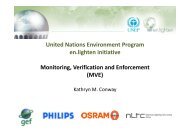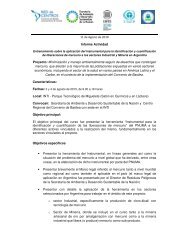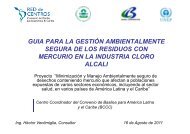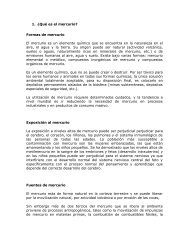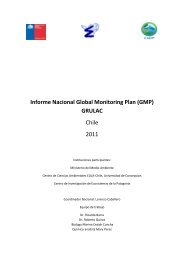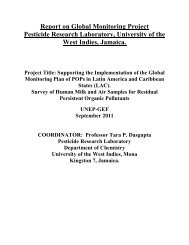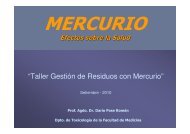Standard Operating Procedure for POP Sampling in Breast Milk
Standard Operating Procedure for POP Sampling in Breast Milk
Standard Operating Procedure for POP Sampling in Breast Milk
Create successful ePaper yourself
Turn your PDF publications into a flip-book with our unique Google optimized e-Paper software.
<strong>Standard</strong> <strong>Operat<strong>in</strong>g</strong> <strong>Procedure</strong> <strong>for</strong> <strong>POP</strong><br />
<strong>Sampl<strong>in</strong>g</strong> <strong>in</strong> <strong>Breast</strong> <strong>Milk</strong><br />
UNEP-GEF Project<br />
Project to Support the Implementation of the Global Monitor<strong>in</strong>g<br />
Plan <strong>for</strong> Persistent Organic Pollutants (<strong>POP</strong>s) <strong>in</strong> the Countries<br />
of Lat<strong>in</strong> America and the Caribbean (LAC)<br />
GFLIPMS 3778<br />
July 2010
<strong>Standard</strong> <strong>Operat<strong>in</strong>g</strong> <strong>Procedure</strong> <strong>for</strong><br />
<strong>POP</strong> <strong>Sampl<strong>in</strong>g</strong> <strong>in</strong> <strong>Breast</strong> <strong>Milk</strong><br />
Page 1 of 20<br />
Table of Contents<br />
1. INTRODUCTION ............................................................................................ 2<br />
2. DOCUMENTS OF REFERENCE ................................................................... 3<br />
3. OBJECTIVES ................................................................................................. 3<br />
4. SCOPE ........................................................................................................... 3<br />
5. METHODOLOGY ........................................................................................... 4<br />
5.1 TYPE, NUMBER AND VOLUME OF SAMPLES ...................................................... 4<br />
5.2 COLLECTION OF SAMPLES ............................................................................. 4<br />
5.3 TRAINING OF COLLABORATORS ...................................................................... 5<br />
5.4 SELECTION OF DONORS AND IMPLEMENTATION OF QUESTIONNAIRE .................. 5<br />
5.5 EXTRACTION, STORAGE AND TRANSPORT OF SAMPLES .................................... 6<br />
5.6 PREPARATION OF COMPOSITE SAMPLES ......................................................... 7<br />
5.7 LABORATORY TESTING AND ANALYTICAL QUALITY ............................................ 7<br />
5.8 RESEARCH ETHICS ...................................................................................... 8<br />
6. ANNEX 1: LIST OF PERSISTENT ORGANIC POLLUTANTS ...................... 9<br />
7. ANNEX 3: SELECTION GUIDE ................................................................... 12<br />
8. ANNEX 4: DONOR’S CONSENT AGREEMENT ......................................... 13<br />
9. ANNEX 5: LIST OF PARTICIPANTS ......................................................... 14<br />
10. ANNEX 6: QUESTIONNAIRE .................................................................... 15
<strong>Standard</strong> <strong>Operat<strong>in</strong>g</strong> <strong>Procedure</strong> <strong>for</strong><br />
<strong>POP</strong> <strong>Sampl<strong>in</strong>g</strong> <strong>in</strong> <strong>Breast</strong> <strong>Milk</strong><br />
Page 2 of 20<br />
1. Introduction<br />
There is general consensus that human breast milk is the best food <strong>for</strong> <strong>in</strong>fants, especially <strong>in</strong><br />
the first six months of life. Not only is breastfeed<strong>in</strong>g important <strong>for</strong> the <strong>in</strong>fant’s growth and development<br />
because of the high quality and easy digestion of the nutrients <strong>in</strong> human breast milk, but it is also<br />
important because body contact strengthens mother-and-child bond<strong>in</strong>g and boosts the child’s<br />
psychological and social development. It is based on this knowledge that the M<strong>in</strong>istry of Health, the<br />
World Health Organization (WHO) and the United Nations Children’s Fund (UNICEF) promote,<br />
encourage, support and protect breastfeed<strong>in</strong>g.<br />
In pursuance of the above, the country coord<strong>in</strong>ation must raise awareness on the issue<br />
among all the collaborators <strong>in</strong>volved <strong>in</strong> the study, highlight<strong>in</strong>g the benefits of breastfeed<strong>in</strong>g <strong>for</strong> <strong>in</strong>fant’s<br />
health, and stat<strong>in</strong>g that the practice should be <strong>in</strong>centivized. Participants should bear <strong>in</strong> m<strong>in</strong>d that the<br />
sampl<strong>in</strong>g of milk can by no means h<strong>in</strong>der the feed<strong>in</strong>g and well-be<strong>in</strong>g of <strong>in</strong>fants and donors.<br />
The World Health Organization (WHO) and the scientific community <strong>in</strong> general have<br />
especially focused on the Persistent Organic Pollutants (<strong>POP</strong>s), ow<strong>in</strong>g to their high persistence <strong>in</strong> the<br />
environment, their high toxicity and potential adverse effects on human health and deleterious effects<br />
on other liv<strong>in</strong>g be<strong>in</strong>gs. In view of the sound evidence of their toxicity, and seek<strong>in</strong>g to promote chemical<br />
safety, WHO has called <strong>for</strong> <strong>in</strong>ternational action <strong>in</strong> the control and reduction of such substances <strong>in</strong> the<br />
different environmental compartments.<br />
S<strong>in</strong>ce 1976, WHO has devoted special attention to these pollutants, and has been collect<strong>in</strong>g<br />
<strong>in</strong><strong>for</strong>mation on <strong>POP</strong>s <strong>in</strong> foodstuff, also <strong>in</strong>clud<strong>in</strong>g human milk. Three <strong>in</strong>ternational studies were<br />
conducted dur<strong>in</strong>g the 1987 – 2003 period, to evaluate the levels and trends of <strong>POP</strong>s <strong>in</strong> human milk.<br />
Human milk, blood and fatty tissue are relevant matrixes <strong>for</strong> the evaluation of the body <strong>POP</strong><br />
burden, but human milk is recognized as the matrix of choice ow<strong>in</strong>g to its many advantages, such as<br />
the easy collection of its samples with a non <strong>in</strong>vasive technique. In addition to provid<strong>in</strong>g <strong>in</strong><strong>for</strong>mation on<br />
the exposure of mothers and their children, monitor<strong>in</strong>g of human milk can provide <strong>in</strong><strong>for</strong>mation on the<br />
need <strong>for</strong> measures to reduce the levels of these substances <strong>in</strong> foodstuff, the primary source of<br />
exposure <strong>in</strong> the general population, and consequently <strong>in</strong> the environment.<br />
The United Nations Environment Program (UNEP) and WHO are currently coord<strong>in</strong>at<strong>in</strong>g<br />
Round 4 of the Study of <strong>POP</strong>s <strong>in</strong> Human <strong>Milk</strong>, <strong>in</strong> pursuance of the Global Monitor<strong>in</strong>g Program, which is<br />
part of the actions set <strong>for</strong>th by the Stockholm Convention, <strong>in</strong> its ef<strong>for</strong>t to reduce/elim<strong>in</strong>ate the release of<br />
<strong>POP</strong>s <strong>in</strong>to the environment.<br />
Below is the list of the people that participated <strong>in</strong> the development of the document here<strong>in</strong>:<br />
Dr. Heidelore Fiedler, UNEP, Chemicals<br />
Dr. Ana Maria Cheble Bahia Braga, ENSP/FIOCRUZ<br />
Chem. Thelma Pavesi, ENSP/FIOCRUZ<br />
Dr. Thomas Manfred Krauss, ENSP/FIOCRUZ<br />
Chem. Eng<strong>in</strong>eer Alejandra Torre<br />
B.A. Sandra Castro<br />
Chem. Virg<strong>in</strong>ia Santana
<strong>Standard</strong> <strong>Operat<strong>in</strong>g</strong> <strong>Procedure</strong> <strong>for</strong><br />
<strong>POP</strong> <strong>Sampl<strong>in</strong>g</strong> <strong>in</strong> <strong>Breast</strong> <strong>Milk</strong><br />
Page 3 of 20<br />
2. Documents of reference<br />
Guide <strong>for</strong> the development of a national protocol, <strong>for</strong> the Fourth Study on Persistent Organic<br />
Pollutants <strong>in</strong> <strong>Breast</strong> <strong>Milk</strong>, coord<strong>in</strong>ated by WHO <strong>in</strong> collaboration with the United Nations Environment<br />
Program (UNEP), (Revised on October 1 2007).<br />
3. Objectives<br />
Provide <strong>in</strong><strong>for</strong>mation on the impact of <strong>POP</strong>s on health by:<br />
<br />
<br />
<br />
Expand<strong>in</strong>g and strengthen<strong>in</strong>g the studies of WHO’s Global Environment Monitor<strong>in</strong>g System<br />
(GEMS) on human exposure to all the <strong>POP</strong>s <strong>in</strong>cluded <strong>in</strong> the Stockholm Convention;<br />
Provid<strong>in</strong>g data on human exposure to <strong>POP</strong>s to all the health, environment, agriculture and<br />
fishery sectors, so they can use them when assess<strong>in</strong>g and manag<strong>in</strong>g risk;<br />
Identify<strong>in</strong>g needs <strong>for</strong> future studies, <strong>in</strong>clud<strong>in</strong>g prospective epidemiological studies.<br />
Provide accessible, reliable and comparable data on the <strong>POP</strong> levels <strong>in</strong> breast milk <strong>for</strong> the<br />
purposes of the Stockholm Convention:<br />
<br />
<br />
<br />
Assist <strong>in</strong> the development and review of the National Implementation Plan <strong>in</strong> accordance with<br />
Article 7 of this Convention;<br />
Contribute to the Effectiveness Evaluation of the Stockholm Convention <strong>in</strong> relation with the<br />
reduction and elim<strong>in</strong>ation of <strong>POP</strong> releases <strong>in</strong>to the environment, as required <strong>in</strong> Article 16;<br />
Approach relevant measures of Article 11 of the Convention with regard <strong>in</strong>vestigation and<br />
monitor<strong>in</strong>g of <strong>POP</strong>s.<br />
4. Scope<br />
This procedure shall apply to the sampl<strong>in</strong>g of breast milk <strong>in</strong> all the countries that participate <strong>in</strong><br />
the GEF Project.
<strong>Standard</strong> <strong>Operat<strong>in</strong>g</strong> <strong>Procedure</strong> <strong>for</strong><br />
<strong>POP</strong> <strong>Sampl<strong>in</strong>g</strong> <strong>in</strong> <strong>Breast</strong> <strong>Milk</strong><br />
Page 4 of 20<br />
5. Methodology<br />
5.1 Type, number and volume of samples<br />
This guide only approaches a study with one sampl<strong>in</strong>g period. The samples obta<strong>in</strong>ed <strong>in</strong> that<br />
period will be used to determ<strong>in</strong>e the reference concentrations of <strong>POP</strong>s <strong>in</strong> <strong>in</strong>dividual randomly selected<br />
samples of breast milk and <strong>in</strong> composite samples prepared with them.<br />
The use of composite samples is recommended to determ<strong>in</strong>e the concentrations of diox<strong>in</strong>-like<br />
PCDD, PCDF and PCB <strong>in</strong> human breast milk and <strong>in</strong>dividual samples to determ<strong>in</strong>e basic <strong>POP</strong> pesticides<br />
and PCB markers. In the document here<strong>in</strong>, those two groups of contam<strong>in</strong>ants will be referred to as<br />
“analytically simple <strong>POP</strong>s” and “analytically complex <strong>POP</strong>s”, respectively. Annex 2 conta<strong>in</strong>s a list of the<br />
analytically simple <strong>POP</strong>s (basic <strong>POP</strong>s) and complex <strong>POP</strong>s (diox<strong>in</strong>-like <strong>POP</strong>s) <strong>in</strong>cluded <strong>in</strong> this guide, as<br />
well as a list of the breakdown related products, to be tested and reported together with the precursor<br />
compounds.<br />
As an <strong>in</strong>ternal analytical quality control method, the analytically simple <strong>POP</strong>s will also be<br />
tested <strong>in</strong> the composite sample, because the average value obta<strong>in</strong>ed from the <strong>in</strong>dividual<br />
samples must be equal to the value <strong>in</strong> the composite sample. Moreover, composite and/or<br />
<strong>in</strong>dividual samples may be used to determ<strong>in</strong>e other <strong>POP</strong>s that are currently not covered by the<br />
Stockholm Convention, based on the country’s priorities and the resources available. Annex 2<br />
provides a list of optional <strong>POP</strong>s that may be <strong>in</strong>cluded <strong>in</strong> the analysis of the composite samples.<br />
In order to obta<strong>in</strong> statistically reliable data, it is essential to recruit an appropriate number of<br />
<strong>in</strong>dividual sample donors. In pr<strong>in</strong>ciple, it is recommended to <strong>in</strong>clude a m<strong>in</strong>imum of 50 <strong>in</strong>dividual samples<br />
per country. However, it is recognized that countries with a small number of <strong>in</strong>habitants, low birth rates,<br />
or both, may require a certa<strong>in</strong> flexibility. If that were the case, the first choice to <strong>in</strong>crease the number of<br />
donors should be to extend the period <strong>for</strong> collect<strong>in</strong>g samples. Under certa<strong>in</strong> circumstances the<br />
reduction of the number of donors is <strong>in</strong>evitable; <strong>in</strong> such cases, <strong>in</strong>vestigators must thoroughly weigh the<br />
effect of sample size reduction on the statistical power of the study, to detect differences between<br />
different periods. Conversely, the study’s statistical power may be enhanced by <strong>in</strong>clud<strong>in</strong>g more than 50<br />
<strong>in</strong>dividual samples, and this option is recommended. Especially, countries with over 50 million<br />
<strong>in</strong>habitants should <strong>in</strong>clude at least one additional participant per million people exceed<strong>in</strong>g 50 million.<br />
Countries whose populations exceed the 50-million threshold by far (or who can af<strong>for</strong>d the resources)<br />
are recommended to prepare a second composite sample (or more) if possible. The Country<br />
Coord<strong>in</strong>ator is responsible <strong>for</strong> guarantee<strong>in</strong>g that the number of samples collected <strong>for</strong> analysis provides<br />
a statistical base, sufficient to ensure that the evaluations of the changes that may occur <strong>in</strong> the <strong>POP</strong><br />
concentrations with time are scientifically valid. Annex 3 conta<strong>in</strong>s some statistical aspects to be<br />
considered <strong>in</strong> the design of the protocol.<br />
5.2 Collection of samples<br />
The collection of breast milk will be coord<strong>in</strong>ated by the national laboratory. Collection should be<br />
per<strong>for</strong>med <strong>in</strong> breast milk banks (BMBs) when available, or at hospitals, when BMBs are not available <strong>in</strong><br />
the country. Below are the advantages of us<strong>in</strong>g BMBs <strong>for</strong> collection of samples:<br />
The sampl<strong>in</strong>g is per<strong>for</strong>med by skilled professionals, qualified <strong>for</strong> collect<strong>in</strong>g breast milk and handl<strong>in</strong>g<br />
samples;<br />
<strong>Milk</strong> Banks have the k<strong>in</strong>d of <strong>in</strong>frastructure required <strong>for</strong> an adequate storage of samples;
<strong>Standard</strong> <strong>Operat<strong>in</strong>g</strong> <strong>Procedure</strong> <strong>for</strong><br />
<strong>POP</strong> <strong>Sampl<strong>in</strong>g</strong> <strong>in</strong> <strong>Breast</strong> <strong>Milk</strong><br />
Page 5 of 20<br />
The professionals acknowledge the importance of breastfeed<strong>in</strong>g and encourage the potential<br />
donors to breastfeed.<br />
One of the issues to be considered when select<strong>in</strong>g the Banks is the ease with which the<br />
samples can be sent fast to the laboratory that coord<strong>in</strong>ates the study, located <strong>in</strong> areas with a high<br />
population density.<br />
All the Banks will be contacted, and after clarify<strong>in</strong>g the purpose of the study, a pre-selection will<br />
be made among those that show <strong>in</strong>terest and will<strong>in</strong>gness to collaborate. The banks selected must<br />
represent their countries. The countries should be divided <strong>in</strong>to more regions and the banks available <strong>in</strong><br />
each region should be selected at random, to ensure a vast geographical distribution of the sampl<strong>in</strong>g<br />
sites across the country. To determ<strong>in</strong>e the total number of Banks needed, the country coord<strong>in</strong>ation will<br />
have to:<br />
Determ<strong>in</strong>e the total number of <strong>in</strong>dividual samples that need to be collected<br />
Consider that at least 5 samples will have to be collected per site, with a maximum of 10 samples<br />
per site;<br />
The same number of samples will be collected per site (UNEP composite sample - 50 persons<br />
- five regions – two BMBs per region – five samples per BMB)<br />
5.3 Tra<strong>in</strong><strong>in</strong>g of collaborators<br />
After select<strong>in</strong>g the breast milk banks and hospitals, the study coord<strong>in</strong>ators will visit the sites<br />
selected to <strong>in</strong><strong>for</strong>m about the study details and the tra<strong>in</strong><strong>in</strong>g it <strong>in</strong>volves, the selection of donors and the<br />
implementation of the questionnaire, as well as to clarify any doubts that may arise when the<br />
procedures are implemented. At that brief<strong>in</strong>g visit, the coord<strong>in</strong>ators will leave the previously prepared<br />
collection jars and all the material that will be needed (e.g.: questionnaires).<br />
5.4 Selection of donors and implementation of questionnaire<br />
The potential donors will be recruited among mothers that seek a milk bank to donate milk or<br />
who donate milk at the hospital. Primarily, they must meet the selection criteria recommended <strong>in</strong> the<br />
guide developed by WHO:<br />
Primiparas;<br />
Mothers not older than 30 years of age;<br />
Both mother and child must be apparently healthy, and pregnancy had to be normal;<br />
The mother must be breastfeed<strong>in</strong>g only one child (e.g.: no tw<strong>in</strong>s);
<strong>Standard</strong> <strong>Operat<strong>in</strong>g</strong> <strong>Procedure</strong> <strong>for</strong><br />
<strong>POP</strong> <strong>Sampl<strong>in</strong>g</strong> <strong>in</strong> <strong>Breast</strong> <strong>Milk</strong><br />
Page 6 of 20<br />
Only mothers that have lived at least ten years <strong>in</strong> the area must be <strong>in</strong>cluded;<br />
Only mothers that are exclusively or primarily breastfeed<strong>in</strong>g must be <strong>in</strong>cluded;<br />
The mother must not live <strong>in</strong> the vic<strong>in</strong>ity of <strong>in</strong>c<strong>in</strong>erators, paper mills, metal factories and chemicals<br />
factories;<br />
The mother must be available <strong>for</strong> the extraction of the sample between the third and eighth week<br />
postpartum.<br />
The mothers that meet all these requirements will be <strong>in</strong>vited to participate <strong>in</strong> the study by sign<strong>in</strong>g the Consent<br />
Agreement (Annex 4). Each mother <strong>in</strong>cluded <strong>in</strong> the study must be identified with a s<strong>in</strong>gle code, the same that<br />
will appear by her name <strong>in</strong> the List of Participants (Annex 5). This code will be recorded <strong>in</strong> the Selection Guide,<br />
<strong>in</strong> the Consent Agreement, <strong>in</strong> the Individual Questionnaire and the collection jar. Be<strong>for</strong>e the milk is collected,<br />
the donor will be <strong>in</strong>terviewed by a milk bank professional, and will provide <strong>in</strong><strong>for</strong>mation about her hous<strong>in</strong>g and<br />
feed<strong>in</strong>g habits, <strong>in</strong> accordance with the Individual Questionnaire (Annex 6).<br />
5.5 Extraction, storage and transport of samples<br />
The collection will be conducted at the human milk banks between the 3 th and 8 th weeks postpartum. The<br />
total volume of the breast milk to be sampled from each mother will be 100 ml. This volume can be obta<strong>in</strong>ed<br />
easily without impair<strong>in</strong>g the <strong>in</strong>fant’s feed<strong>in</strong>g.<br />
No other conta<strong>in</strong>ers may be used to collect the milk. Preferably, the extraction must be per<strong>for</strong>med manually,<br />
express<strong>in</strong>g the milk directly <strong>in</strong>to the jar provided <strong>for</strong> that purpose.<br />
<strong>Breast</strong>s and hands should be ma<strong>in</strong>ta<strong>in</strong>ed as clean as possible, avoid<strong>in</strong>g the use of soap. When the mother is<br />
us<strong>in</strong>g some o<strong>in</strong>tment (<strong>for</strong> cracked nipples, or other medical reasons), the application must be limited to the<br />
moments between the extractions of milk, and the product should be completely removed, wash<strong>in</strong>g the breasts<br />
prior to the procedure.<br />
Each mother must be given an identification code number, to match the code on the milk collection jar. The<br />
jars are supplied by the study coord<strong>in</strong>ators, after they have undergone an adequate chemical treatment to<br />
ensure they are free from contam<strong>in</strong>ation, and with three potassium dichromate pellets to preserve the samples<br />
appropriately. The sample must be collected directly <strong>in</strong>to the conta<strong>in</strong>er; if the sample is taken at the mother’s<br />
home, the jar must be refrigerated until its delivery. The sample may be kept <strong>in</strong> the refrigerator, at<br />
approximately 4 °C, <strong>for</strong> no longer than 72 hours, or <strong>in</strong> the freezer, at -20 °C, <strong>for</strong> longer periods. If the sample<br />
cannot be refrigerated, you can add a small tablet of potassium dichromate (K2Cr2O7) <strong>for</strong> chemically sterilized<br />
milk.<br />
After the collection of samples, the fifty 50-ml samples must be sent to the laboratory appo<strong>in</strong>ted by the<br />
Country Coord<strong>in</strong>ator. Sample shipment must be per<strong>for</strong>med by professional carriers or through other means, as<br />
expeditiously as possible. Samples are frozen at -20 °C, wrapped <strong>in</strong> dry ice and sent to dest<strong>in</strong>ation. In the<br />
countries where the temperature cannot be controlled, the samples are preserved by add<strong>in</strong>g 100 mg of<br />
potassium dichromate every 250 ml of milk. All the <strong>in</strong>dividual or composite samples must carry a label with one<br />
s<strong>in</strong>gle identification code. The composite samples must be sent to the WHO Reference Laboratory, together<br />
with the summarized <strong>in</strong><strong>for</strong>mation (see Annex 8). The laboratory that receives the samples must be <strong>in</strong><strong>for</strong>med on<br />
the shipp<strong>in</strong>g date and the expected date of arrival, and must confirm their reception.
<strong>Standard</strong> <strong>Operat<strong>in</strong>g</strong> <strong>Procedure</strong> <strong>for</strong><br />
<strong>POP</strong> <strong>Sampl<strong>in</strong>g</strong> <strong>in</strong> <strong>Breast</strong> <strong>Milk</strong><br />
Page 7 of 20<br />
5.6 Preparation of composite samples<br />
The samples must be handled by qualified personnel, to guarantee their <strong>in</strong>tegrity. Individual milk<br />
samples must be homogenized by heat<strong>in</strong>g them at 38 °C and shak<strong>in</strong>g them <strong>for</strong> 10 m<strong>in</strong>utes, after which<br />
the laboratory must prepare <strong>in</strong>dividual samples and composite samples. The <strong>in</strong>dividual samples must<br />
conta<strong>in</strong> 25 ml of breast milk <strong>for</strong> the analysis of analytically simple <strong>POP</strong>s, as pesticide <strong>POP</strong>s and PCB<br />
markers. As to the composite sample, 10 ml of each one of the 50 <strong>in</strong>dividual samples must be taken to<br />
obta<strong>in</strong> a 500-ml composite sample. Of those 500 ml, 50 ml must be kept aside <strong>for</strong> the analysis of simple<br />
<strong>POP</strong>s by the participant countries, and the rest, 450 ml, will be analyzed by the WHO Reference<br />
Laboratory. The latter will analyze both analytically simple and complex <strong>POP</strong>s, such as diox<strong>in</strong>-like PCBs,<br />
PCDD and PCDF. The rest of the sample collected from <strong>in</strong>dividual donors, (15 ml), must be mixed to<br />
obta<strong>in</strong> a 750-ml composite sample that will be sent to WHO <strong>for</strong> its Human <strong>Milk</strong> Global Bank. The Bank’s<br />
reserve will be used <strong>in</strong> the future if new <strong>POP</strong>s are added to the Stockholm Convention, as well as <strong>for</strong><br />
other scientific purposes. Countries with adequate resources may opt to obta<strong>in</strong> more than one<br />
composite sample from the 50 <strong>in</strong>dividual samples; <strong>for</strong> example, one composite sample obta<strong>in</strong>ed with 25<br />
<strong>in</strong>dividual samples. However, not all the composite samples need to conta<strong>in</strong> 500 ml. If the country<br />
wishes to analyze other contam<strong>in</strong>ants <strong>in</strong> aliquots of the composite samples, the protocol <strong>for</strong> sample<br />
collection will need to be modified accord<strong>in</strong>gly (either to <strong>in</strong>clude more donors or to <strong>in</strong>crease the volume<br />
of each milk sample). More <strong>in</strong><strong>for</strong>mation is available at the WHO Reference Laboratory.<br />
5.7 Laboratory test<strong>in</strong>g and analytical quality<br />
All the composite samples will be tested at the Laboratory <strong>for</strong> Diox<strong>in</strong>s and Agrotoxic Substances<br />
of the "Chemisches and Veter<strong>in</strong>äruntersuchungsamt Freiburg" (CVUA: Community Reference<br />
Laboratory <strong>for</strong> Chemical Test<strong>in</strong>g of Foods of Animal Orig<strong>in</strong>), <strong>in</strong> Freiburg, Germany. This laboratory was<br />
appo<strong>in</strong>ted as a WHO Reference Laboratory <strong>for</strong> the study, hav<strong>in</strong>g met all the requirements established by<br />
WHO at the Fourth Round <strong>for</strong> the Interlaboratory Calibration of PCDD, PCDF and PCB levels <strong>in</strong> human<br />
milk.<br />
The Reference Laboratory follows a rigorous quality control program to guarantee the accuracy<br />
and reliability of the results obta<strong>in</strong>ed <strong>in</strong> the study. The laboratory runs this program daily <strong>in</strong> the rout<strong>in</strong>e<br />
test<strong>in</strong>g <strong>for</strong> PCDD, PCDF and PCB and <strong>POP</strong> agrotoxics, primarily on foodstuff samples.<br />
The elements below are part of the quality program:<br />
Test<strong>in</strong>g of reagent blank samples;<br />
Test<strong>in</strong>g of <strong>for</strong>tified samples (ref<strong>in</strong>ed vegetal oil);<br />
Test<strong>in</strong>g of reference samples (known concentrations);<br />
The analytical procedures <strong>for</strong> the PCDD/PCDF and PCB will be per<strong>for</strong>med <strong>in</strong> accordance with<br />
the procedure described by Malisch and Leeuwen (2002) 1 . Follow<strong>in</strong>g freeze-dry<strong>in</strong>g, the sample will be<br />
extracted with ethanol/toluene (70:30, v:v) <strong>for</strong> 8 hours <strong>in</strong> a "Twisselmann" extractor. The raw extract,<br />
primarily consist<strong>in</strong>g of fat, will be purified with ether and <strong>for</strong>tified with PCDD/PCDF and PCB <strong>in</strong>-house<br />
standards labeled with 13 C. The fat from the extract will be removed us<strong>in</strong>g gel permeation<br />
chromatography (Bio Beads S-X3). After treat<strong>in</strong>g the extract <strong>in</strong> a multilayer column (silica, silica/sulfuric<br />
acid), the PCDD/PCDF and PCB will be separated <strong>in</strong> a Florisil column. The PCDD/PCDF fraction will be<br />
treated <strong>in</strong> an activated charcoal column and later analyzed <strong>in</strong> a High Resolution Gas Chromatographer<br />
1 Malisch, R; Leeuwen FXR. (2002). Organohalogen Compounds 56, 317-320.
<strong>Standard</strong> <strong>Operat<strong>in</strong>g</strong> <strong>Procedure</strong> <strong>for</strong><br />
<strong>POP</strong> <strong>Sampl<strong>in</strong>g</strong> <strong>in</strong> <strong>Breast</strong> <strong>Milk</strong><br />
Page 8 of 20<br />
coupled to a Low Resolution Mass Spectrometer (HRGC/LRMS). The PCB fraction will also be treated<br />
<strong>in</strong> an activated charcoal column to separate it <strong>in</strong>to three fractions: non-ortho, mono-ortho and di-ortho<br />
PCB. Each fraction will be analyzed with HRGC/LRMS.<br />
The analytical method <strong>for</strong> agrotoxic <strong>POP</strong>s will be based on the pr<strong>in</strong>ciples set <strong>for</strong>th <strong>in</strong> the Official<br />
Methods of the German Federal Food Act, <strong>for</strong> the Analysis of Agrotoxic Residues <strong>in</strong> Foodstuffs 2 .<br />
Follow<strong>in</strong>g freeze-dry<strong>in</strong>g, the sample will be extracted with ethanol/toluene (70:30, v:v) <strong>for</strong> 8 hours <strong>in</strong> a<br />
"Twisselmann" extractor. The raw extract, primarily consist<strong>in</strong>g of fat, will be purified with ether and<br />
<strong>for</strong>tified with <strong>in</strong>-house standards. The fat will be removed from the extract through gel permeation<br />
chromatography (Bio Beads S-X3). The extract will subsequently treated <strong>in</strong> a partially deactivated silica<br />
column. The determ<strong>in</strong>ation of the agrotoxic <strong>POP</strong>s will be per<strong>for</strong>med <strong>in</strong> a gas chromatographer with<br />
electron capture detector (ECD). The results will be confirmed <strong>in</strong> a High Resolution Gas<br />
Chromatographer coupled to a Low Resolution Mass Spectrometer.<br />
The analysis of agrotoxic <strong>POP</strong>s and the PCB markers <strong>in</strong> the <strong>in</strong>dividual samples will be per<strong>for</strong>med<br />
at the national <strong>POP</strong> Laboratory, if available.<br />
5.8 Research Ethics<br />
The human milk samples collected and the questionnaires completed will be used specifically<br />
<strong>for</strong> the purposes of this research, and shall not be employed <strong>for</strong> other purposes. Any data provided by<br />
mothers that may permit their personal identification, will be ma<strong>in</strong>ta<strong>in</strong>ed confidential and shall not be<br />
disclosed.<br />
2 Collection of Official Methods under Article 35 of the German Federal Food Act, Modular Multiple Analytical<br />
Method <strong>for</strong> the Determ<strong>in</strong>ation of Pesticide Residues <strong>in</strong> Foodstuffs, L 00.00-34, November 1999
<strong>Standard</strong> <strong>Operat<strong>in</strong>g</strong> <strong>Procedure</strong> <strong>for</strong><br />
<strong>POP</strong> <strong>Sampl<strong>in</strong>g</strong> <strong>in</strong> <strong>Breast</strong> <strong>Milk</strong><br />
Page 9 of 20<br />
6. Annex 1: List of Persistent Organic Pollutants<br />
A. 12 Initial <strong>POP</strong>s<br />
Simple analysis <strong>POP</strong>s - Agrotoxic <strong>POP</strong>s and PCB markers<br />
Aldr<strong>in</strong><br />
Chlordane (total)<br />
alpha-chlordane (α-chlordane)<br />
gamma-chlordane (γ-chlordane)<br />
oxi-chlordane<br />
cis-nonachlor<br />
trans-nonachlor<br />
Heptachlor (total)<br />
Heptachlor<br />
Heptachlor epoxide (cis)<br />
Heptachlor expoxide (trans)<br />
Hexachlorobenzene (HCB)<br />
Dieldr<strong>in</strong><br />
Mirex<br />
DDT (total)<br />
Toxaphene (total)<br />
o,p'-DDD and p,p'-DDD<br />
o,p'-DDE and p,p'-DDE Parlar 26<br />
o,p'-DDT and p,p'-DDT Parlar 50<br />
Parlar 62<br />
Endr<strong>in</strong> (total)<br />
Endr<strong>in</strong><br />
Endr<strong>in</strong> Ketone<br />
PBC Markers<br />
IUPAC # 28<br />
IUPAC # 52<br />
IUPAC # 101<br />
IUPAC # 118<br />
IUPAC # 138<br />
IUPAC # 153<br />
IUPAC # 180
<strong>Standard</strong> <strong>Operat<strong>in</strong>g</strong> <strong>Procedure</strong> <strong>for</strong><br />
<strong>POP</strong> <strong>Sampl<strong>in</strong>g</strong> <strong>in</strong> <strong>Breast</strong> <strong>Milk</strong><br />
Page 10 of 20<br />
Diox<strong>in</strong>-Like <strong>POP</strong>s<br />
Polychlor<strong>in</strong>ated Dibenzo-p-diox<strong>in</strong>s and Polychlor<strong>in</strong>ated Dibenzofuranes<br />
Polychlorodibenzo-p-diox<strong>in</strong>s (PCDD)<br />
2,3,7,8-Cl4DD<br />
1,2,3,7,8-Cl4DD<br />
1,2,3,4,7,8-Cl6DD<br />
1,2,3,6,7,8-Cl6DD<br />
1,2,3,7,8,9-Cl6DD<br />
1,2,3,4,6,7,8-Cl7DD<br />
Cl8DD<br />
Polychlorodibenzofuranes (PCDF)<br />
2,3,7,8-Cl4DF<br />
1,2,3,7,8-Cl5DF<br />
2,3,4,7,8-Cl5DF<br />
1,2,3,4,7,8-Cl6DF<br />
1,2,3,6,7,8-Cl6DF<br />
1,2,3,7,8,9-Cl6DF<br />
2,3,4,6,7,8-Cl6DF<br />
1,2,3,4,6,7,8-Cl7DF<br />
1,2,3,4,7,8,9-Cl7DF<br />
Cl8DF<br />
Diox<strong>in</strong>-like PCBs<br />
non-ortho PCB<br />
mono-ortho PCB<br />
3,3',4,4'-TeCB (PCB 77) 2,3,3',4,4'-PeCB (PCB 105)<br />
3,4,4',5-TeCB (PCB 81) 2,3,4,4',5-PeCB (PCB 114)<br />
3,3',4,4',5-PeCB (PCB 126) 2,3',4,4',5-PeCB (PCB 118)<br />
3,3',4,4',5,5'-HxCB (PCB 169) 2',3,4,4',5-PeCB (PCB 123)<br />
2,3,3',4,4',5-HxCB (PCB 156)<br />
2,3,3',4,4',4'-HxCB (PCB 157)<br />
2,3',4,4',5,5'-HxCB (PCB 167)<br />
2,3,3',4,4',5,5'-HpCB (PCB 189
<strong>Standard</strong> <strong>Operat<strong>in</strong>g</strong> <strong>Procedure</strong> <strong>for</strong><br />
<strong>POP</strong> <strong>Sampl<strong>in</strong>g</strong> <strong>in</strong> <strong>Breast</strong> <strong>Milk</strong><br />
Page 11 of 20<br />
N<strong>in</strong>e new <strong>POP</strong>s (Listed by the Fourth Conference of the Parties, May 2009)<br />
Chlordecone<br />
Hexachlorocyclohexane (HCH) (total)<br />
Chlordecone<br />
alpha-hexachlorocyclohexane (α-HCH)<br />
beta-hexachlorocyclohexane (β-HCH)<br />
gamma-hexachlorocyclohexane (y-HCH)<br />
Pentachlorobenzene<br />
Polybrom<strong>in</strong>ated diphenyl ethers (PBDE)<br />
BDE 47<br />
BDE 99<br />
BDE 153<br />
BDE 154<br />
BDE 175/BDE 183<br />
Hexabrom<strong>in</strong>ated biphenils (HxBB)<br />
PBB 153<br />
PFOS/PFOA<br />
PFOS - (anion)
<strong>Standard</strong> <strong>Operat<strong>in</strong>g</strong> <strong>Procedure</strong> <strong>for</strong><br />
<strong>POP</strong> <strong>Sampl<strong>in</strong>g</strong> <strong>in</strong> <strong>Breast</strong> <strong>Milk</strong><br />
Page 12 of 20<br />
7. Annex 3: Selection Guide<br />
CONFIDENTIAL<br />
Selection Guide<br />
For donors of breast milk <strong>for</strong> the test<strong>in</strong>g of Persistent Organic Pollutants (<strong>POP</strong>s)<br />
Place of <strong>in</strong>terview: _________________________________________ Date of <strong>in</strong>terview:___/___/___<br />
Interviewee N°:____<br />
Selection criteria:<br />
1. Child more than 2 weeks old and less than 8 weeks old<br />
2. First child<br />
3. Mother not older than 30 years of age<br />
4. Normal pregnancy<br />
5. Mother and child apparently healthy<br />
6. Mother breastfeeds only one child<br />
7. Exclusive breastfeed<strong>in</strong>g, preferably<br />
8. Mother has lived <strong>in</strong> the area <strong>for</strong> 10 years<br />
9. Mother does not live near an <strong>in</strong>c<strong>in</strong>erator, a paper mill, a metal factory or<br />
a chemicals factory<br />
Yes<br />
No<br />
If all the answers are affirmative, <strong>in</strong>vite the mother to participate <strong>in</strong> the study and ask her to sign her consent so<br />
it can be <strong>in</strong>cluded <strong>in</strong> the study.<br />
Mother accepted to participate<br />
Mother signed the consent agreement<br />
Yes<br />
No<br />
If the mother signed the consent agreement, she is to be <strong>in</strong>cluded <strong>in</strong> the study; record her name and address <strong>in</strong> the<br />
List of Participants and determ<strong>in</strong>e her appropriate code. Record this code <strong>in</strong> all the documents and use the jar with<br />
the same code <strong>for</strong> the milk sample.<br />
Identification code of the sample: ______________________<br />
Interviewer (Full name <strong>in</strong> bold types): ____________________________________<br />
Signature:_________________________________________________________
<strong>Standard</strong> <strong>Operat<strong>in</strong>g</strong> <strong>Procedure</strong> <strong>for</strong><br />
<strong>POP</strong> <strong>Sampl<strong>in</strong>g</strong> <strong>in</strong> <strong>Breast</strong> <strong>Milk</strong><br />
Page 13 of 20<br />
8. Annex 4: DONOR’S CONSENT AGREEMENT<br />
I, ________________________________________________________________________________<br />
freely accept to participate <strong>in</strong> the study "Levels of Persistent Organic Pollutants <strong>in</strong> <strong>Breast</strong> <strong>Milk</strong>”,<br />
conducted by…………………………. and the World Health Organization/United Nations Environment<br />
Program, under the coord<strong>in</strong>ation of the <strong>in</strong>vestigators……………….. (e-mail:………………….) and (email:………………………….),<br />
address:………………………. , who may be contacted any time dur<strong>in</strong>g<br />
the research.<br />
Purpose of the study: The study is aimed at quantify<strong>in</strong>g the levels of Persistent Organic Pollutants <strong>in</strong><br />
human milk to estimate the levels of human exposure to <strong>POP</strong>s and the environmental pollution caused<br />
by these agents. <strong>POP</strong>s bio-accumulate <strong>in</strong> animal fat; as human breast milk is rich <strong>in</strong> fat, the dos<strong>in</strong>g of<br />
these substances reflects the degree of exposure of the general population, without requir<strong>in</strong>g <strong>in</strong>vasive<br />
and pa<strong>in</strong>ful extractions.<br />
Study Rationale: The study gives a general view of the population’s levels of exposure <strong>in</strong> several<br />
geographical areas <strong>in</strong> the country. This <strong>in</strong><strong>for</strong>mation and the knowledge developed enables government<br />
agencies to adopt measures to control the environmental pollution caused by these contam<strong>in</strong>ants and<br />
to reduce the health hazards <strong>for</strong> the general population.<br />
Participation: Once my participation is accepted, 100 ml of breast milk will be extracted <strong>in</strong> private. In<br />
addition, I will answer a questionnaire on my personal habits, data on pregnancy, medic<strong>in</strong>es, my work<br />
and my feed<strong>in</strong>g habits. As <strong>in</strong> any study, un<strong>for</strong>eseeable risks may arise, but all the precautions will be<br />
taken to protect my personal safety dur<strong>in</strong>g the phases of the study here<strong>in</strong>.<br />
Benefits: The <strong>in</strong><strong>for</strong>mation obta<strong>in</strong>ed <strong>in</strong> this study can be of scientific use and it may be useful <strong>for</strong> others.<br />
In addition, the presence of these agents <strong>in</strong> question at hazardous levels <strong>in</strong> breast milk will be <strong>in</strong>cluded<br />
<strong>in</strong> the donor mother’s data, attach<strong>in</strong>g due health care measures, and provisions aimed at reduc<strong>in</strong>g<br />
environmental pollution.<br />
Privacy: Any personal <strong>in</strong><strong>for</strong>mation obta<strong>in</strong>ed <strong>in</strong> the <strong>in</strong>vestigation here<strong>in</strong> shall be confidential and shall<br />
only be disclosed with my authorization. The data referr<strong>in</strong>g to me shall be given to the <strong>in</strong>vestigators <strong>in</strong><br />
charge. The scientific data and the medical <strong>in</strong><strong>for</strong>mation derived from the study here<strong>in</strong> can be presented<br />
at conferences and published <strong>in</strong> journals without my identification.<br />
I hereby state that my participation <strong>in</strong> this study is voluntary and that I am aware that my decision not to<br />
participate or to quit the study after be<strong>in</strong>g enrolled will not entail any problems to the<br />
………………………………………….., WHO, UNEP or any other agency or <strong>in</strong>stitution <strong>in</strong>volved. I can<br />
term<strong>in</strong>ate my participation <strong>in</strong> the study at any time and <strong>for</strong> any reason, need<strong>in</strong>g no justifications.<br />
Signature of donor mother<br />
Signature of witness<br />
Date: _____ / ____ /<br />
Investigator<br />
Identification code:________________________________
<strong>Standard</strong> <strong>Operat<strong>in</strong>g</strong> <strong>Procedure</strong> <strong>for</strong><br />
<strong>POP</strong> <strong>Sampl<strong>in</strong>g</strong> <strong>in</strong> <strong>Breast</strong> <strong>Milk</strong><br />
Page 14 of 20<br />
9. Annex 5: List of Participants<br />
Study of the Levels of Persistent Organic Pollutants <strong>in</strong> Human <strong>Milk</strong><br />
Place of Extraction: XXXXXXX/YY Confidential !<br />
Sample code: Name of donor mother Address of donor mother Telephone<br />
ZZ-YY-01<br />
ZZ - YY -02<br />
ZZ - YY -03<br />
ZZ - YY -04<br />
ZZ - YY -05<br />
ZZ - YY -06<br />
ZZ - YY -07<br />
ZZ - YY -08<br />
ZZ - YY -09<br />
ZZ - YY -10
<strong>Standard</strong> <strong>Operat<strong>in</strong>g</strong> <strong>Procedure</strong> <strong>for</strong><br />
<strong>POP</strong> <strong>Sampl<strong>in</strong>g</strong> <strong>in</strong> <strong>Breast</strong> <strong>Milk</strong><br />
Page 15 of 20<br />
10. Annex 6: Questionnaire<br />
For donors of breast milk <strong>for</strong> the analysis of Persistent Organic Pollutants<br />
CONFIDENTIAL!<br />
Questionnaire<br />
1. Country: 2. Area (city or region with<strong>in</strong> the country): 3. Identification code of composite<br />
sample:<br />
XXXXXXX<br />
ZZ-XX<br />
4. Sample identification code: 5. Start and end of extraction<br />
6. Date of mother’s birth:<br />
ZZ-XX___<br />
From: DD/MM/YY<br />
To: DD/MM/YY<br />
DD/MM/YY<br />
7. Mother’s age <strong>in</strong> years: 8. Mother’s height <strong>in</strong> cm: 9. Mother’s weight be<strong>for</strong>e<br />
pregnancy <strong>in</strong> kg<br />
10. Mother’s current<br />
weight <strong>in</strong> kg:<br />
11. Area of residence <strong>in</strong> the last 10 years:<br />
Urban<br />
Rural<br />
12. Previous area of residence:<br />
Years<br />
urban<br />
rural<br />
And earlier<br />
Years<br />
urban<br />
rural<br />
13. Child’s age <strong>in</strong><br />
weeks at start of<br />
sampl<strong>in</strong>g:<br />
14. Child’s sex:<br />
Boy<br />
15. Child’s birthweight<br />
<strong>in</strong> grams:<br />
16. Child’s weight at sampl<strong>in</strong>g<br />
<strong>in</strong> grams<br />
First day:<br />
Girl<br />
en<br />
Last day:
<strong>Standard</strong> <strong>Operat<strong>in</strong>g</strong> <strong>Procedure</strong><br />
<strong>for</strong> <strong>POP</strong> <strong>Sampl<strong>in</strong>g</strong> <strong>in</strong> <strong>Breast</strong> <strong>Milk</strong><br />
Page 16 of 20<br />
17. Mother’s feed<strong>in</strong>g habits be<strong>for</strong>e pregnancy:<br />
Varied diet Vegetarian, but <strong>in</strong>cludes milk and eggs Only vegetarian<br />
Others<br />
Description: _________________________________________<br />
18. Has the mother changed her feed<strong>in</strong>g habits significantly Yes No<br />
s<strong>in</strong>ce she got pregnant<br />
If yes, describe how:___________________________________________________________<br />
___________________________________________________________________________________<br />
19. How often (as an average) did the mother consume fish dur<strong>in</strong>g pregnancy<br />
Never Less than once a week Once a week<br />
Twice a week More than twice a week Every day<br />
Describe the species more frequently consumed by the mother:<br />
___________________________________________________________________________________<br />
____________________________________________________________________________________<br />
20. How often (as an average) did the mother consume sea food dur<strong>in</strong>g pregnancy<br />
Never Less than once a week Once a week<br />
Twice a week More than twice a week Every day<br />
Describe the species more frequently consumed by the mother:<br />
_______________________________________________________________________________<br />
_______________________________________________________________________________
<strong>Standard</strong> <strong>Operat<strong>in</strong>g</strong> <strong>Procedure</strong><br />
<strong>for</strong> <strong>POP</strong> <strong>Sampl<strong>in</strong>g</strong> <strong>in</strong> <strong>Breast</strong> <strong>Milk</strong><br />
Page 17 of 20<br />
21. How often (as an average) did the mother consume sea mammals (e.g. whale) be<strong>for</strong>e pregnancy<br />
Never Less than once a week Once a week<br />
Twice a week More than twice a week Every day<br />
Describe the species more frequently consumed by the mother:<br />
_______________________________________________________________________<br />
_______________________________________________________________________<br />
22. How often (as an average) did the mother consume milk be<strong>for</strong>e pregnancy<br />
Never Less than once a week Once a week<br />
Twice a week More than twice a week Every day<br />
Type of milk:_______________________________________________________________<br />
Daily consumption:<br />
Less than 250 ml 250 – 499 ml 500 ml or more<br />
23. How often (as an average) did the mother consume cheese be<strong>for</strong>e pregnancy<br />
Never Less than once a week Once a week<br />
Twice a week More than twice a week Every day<br />
Type of cheese: __________________________________________________________________<br />
24. How often (as an average) did the mother consume other dairy products (e.g. butter, yoghurt) be<strong>for</strong>e<br />
pregnancy<br />
Never Less than once a week Once a week<br />
Twice a week More than twice a week Every day<br />
Type of product: ________________________________________________________________
<strong>Standard</strong> <strong>Operat<strong>in</strong>g</strong> <strong>Procedure</strong><br />
<strong>for</strong> <strong>POP</strong> <strong>Sampl<strong>in</strong>g</strong> <strong>in</strong> <strong>Breast</strong> <strong>Milk</strong><br />
Page 18 of 20<br />
25. How often (as an average) did the mother consume meat be<strong>for</strong>e pregnancy<br />
Never Less than once a week Once a week<br />
Twice a week More than twice a week Every day<br />
Describe the type of meat more frequently consumed by the mother:<br />
_______________________________________________________________________<br />
_______________________________________________________________________<br />
26. How often (as an average) did the mother consume eggs be<strong>for</strong>e pregnancy<br />
Never Less than once a week Once a week<br />
Twice a week More than twice a week Every day<br />
27. Mother’s smok<strong>in</strong>g habits:<br />
She does not smoke Former smoker Current smoker<br />
If she smokes, what does she smoke Cigarette Cigar Pipe<br />
If she smokes cigarettes, how many a day<br />
If she smokes cigars, how many a day<br />
28. Did the mother work be<strong>for</strong>e pregnancy<br />
Yes<br />
No<br />
If the answer is yes, describe the type of job (function, activities, contact with hazardous goods, etc.)<br />
and duration <strong>in</strong> years:<br />
____________________________________________________________________________<br />
_____________________________________________________________________________
<strong>Standard</strong> <strong>Operat<strong>in</strong>g</strong> <strong>Procedure</strong><br />
<strong>for</strong> <strong>POP</strong> <strong>Sampl<strong>in</strong>g</strong> <strong>in</strong> <strong>Breast</strong> <strong>Milk</strong><br />
Page 19 of 20<br />
29: Types of past jobs:<br />
30. Duration <strong>in</strong> years<br />
a)___________________________________________________________<br />
___________________________________________________________<br />
b)__________________________________________________________<br />
__________________________________________________________<br />
Never worked<br />
31. Was the donor’s mother born <strong>in</strong> Brazil Yes No<br />
31. Was the donor herself breastfed<br />
Yes No I don’t know<br />
If the answer is yes, how long_________________<br />
32. Was the donor’s house treated with DDT to kill mosquitoes<br />
Yes No I don’t know<br />
If the answer is yes, when_________________<br />
33. Medic<strong>in</strong>es used dur<strong>in</strong>g the sampl<strong>in</strong>g period, <strong>for</strong> how long and at what dosages (<strong>in</strong>clud<strong>in</strong>g vitam<strong>in</strong>s and natural<br />
supplements):<br />
_________________________________________________________________________<br />
_________________________________________________________________________<br />
_________________________________________________________________________<br />
_________________________________________________________________________<br />
Questionnaire completed by:<br />
(bold types)<br />
Date:<br />
Signature:


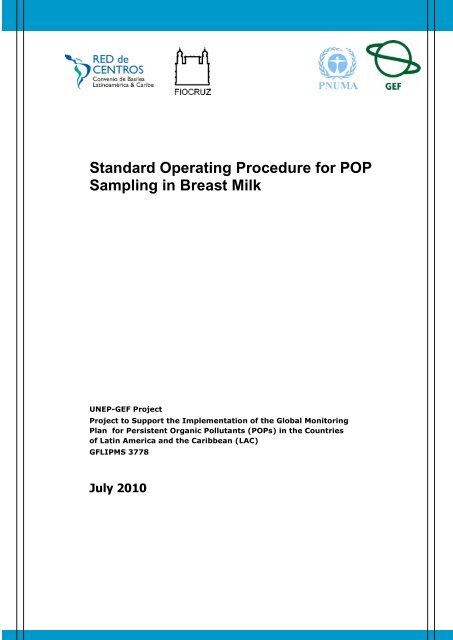


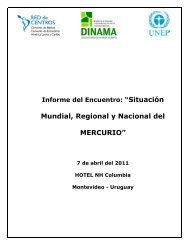
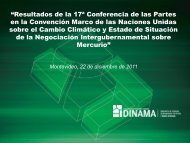

![COP_aire [Compatibility Mode] - Centro Coordinador de Basilea ...](https://img.yumpu.com/44106171/1/190x134/cop-aire-compatibility-mode-centro-coordinador-de-basilea-.jpg?quality=85)
